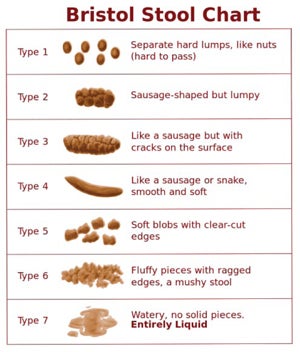Constipation
 Constipation is defined as:
Constipation is defined as:
- Decreased frequency of bowel movements (generally every 3 or more days)
- Stool is harder, making it difficult or painful to pass
- Incomplete evacuation of bowel movement (BM) – Cannot pass all of the stool
Diagnosing Constipation
Using the Bristol stool chart will help you tell your doctor the kind of BMs your child is having. It is important for your doctor to know this so he or she can properly diagnose and treat your child.
A normal stool should be types 4 and 5. Type 6 may be normal for infants. Types 1-3 may suggest constipation and types 6 and 7 may suggest diarrhea.
It is also important to tell the doctor:
- About any prescription and over-the-counter medications and vitamins and supplements your child takes
- If your child’s abdomen (lower stomach) is swollen and/or hard (abdominal distension)
- If your child has lost weight or is not eating very much if at all
- If your child has a lot of rectal bleeding. It is not unusual to have an occasional small amount of rectal bleeding due to anal fissure.
Treating Constipation
Treating constipation is not an exact science. There are several treatment options to meet the unique needs of each child. Commonly used medications are available over the counter. Treatment typically includes diet changes and medications and has two phases – a three-day, aggressive, cleanout phase and a maintenance phase. Depending on your child’s age, the doctor may recommend one of the following plans.
Age 0-2 Years
Initial approach may include:
- prune/apple juice 2-3 oz. daily
- glycerin suppository
- rectal stimulation using Q tip or rectal thermometer
- consider limiting dairy intake
If the above approaches do not work by themselves, consider adding one of the following medications. Before you do, talk to your child’s doctor. It is important to include your child’s doctor in medical decision-making.
- ¼ capful polyethylene glycol (PEG) (also known as MiraLax, ClearLax, GlycoLax, etc.) daily, with or without glycerin suppository
- ½ capful PEG daily, with or without glycerin suppository
Continue the dose of PEG that works; give glycerin suppository if no BM in 3 days
Toddlers and Pre-Pubertal Children
Initial Phase
- Limit dairy intake
- High fiber diet (age + 5 grams daily) – use soluble fibers such as ‘psyllium husk’
- Drink plenty of water
- Avoid withholding behavior
- Scheduled toilet times – before school, after every meal
- Encourage using bathrooms in school
If the above approaches do not work by themselves, consider adding one of the following medications. Before you do, talk to your child’s doctor. It is important to include your child’s doctor in medical decision-making.
- Start polyethylene glycol (PEG) (also known as MiraLax, ClearLax, GlycoLax, etc.) ½ capful daily
- If no help, double PEG dose (max 6 capfuls daily) until stools are soft.
If no success add a stimulant medication (twice a week)
- age 2-3 years: ½ Ex-Lax, or 1 glycerin or dulcolax suppository
- age 3-6 years: ½ to 1 Ex-Lax or ½ pediatric Fleet enema
- age 6 and above: 1-2 Ex-Lax or 1 pediatric Fleet enema
Maintenance Phase
- PEG – use the dose that worked before (every day)
- Stimulant medication – that worked before (twice a week)
Patients with purposeful withholding behavior due to control issues – referral to psychologist or behavioral therapist.
Teenagers
Initial Phase
- Limit dairy intake
- High fiber diet (age+5 grams daily) – use soluble fibers such as ‘psyllium husk’
- Drink plenty of water
- Avoid withholding behavior - encourage using bathrooms in school
- Scheduled toilet times – after every meal
If the above approaches do not work by themselves, consider adding one of the following medications. Before you do, talk to your child’s doctor. It is important to include your child’s doctor in medical decision-making.
- Start polyethylene glycol (PEG) (also known as MiraLax, ClearLax, GlycoLax, etc.) 1 capful daily
- If no success, double PEG dose (max 6 capfuls daily) until stools are soft
- If no success add a stimulant medication (twice a week): 1-2 Ex-Lax or 1 pediatric fleet enema
Maintenance Phase
- PEG – dose that worked before (every day)
- Stimulant medication – that has worked before (twice a week)
Patients with purposeful withholding behavior due to control issues – referral to psychologist or behavioral therapist.
It may take a few days for the treatment to work. Contact your child’s doctor if you have questions or you do not feel the treatment is working after several days.
Printable Patient Information
Management of Functional Constipation
Constipation Cleanout Instructions
Make an Appointment
If you or someone you care for is experiencing worrisome symptoms, we encourage you to make an appointment with one of our pediatric gastroenterologists, adult gastroenterologists or colorectal surgeons.